 | | | Switch to: Europe, USA, New Zealand, Antarctica Credit: NOAA/Ovation  Planetary K-index Planetary K-index
Now: Kp= 3.00 quiet
24-hr max: Kp= 3.00 quiet
explanation | more data
Interplanetary Mag. Field
Btotal: 14.09 nT
Bz: 1.89 nT north
more data: ACE, DSCOVR
Updated: Today at 1147 UT  Coronal Holes: 16 Jul 23 Coronal Holes: 16 Jul 23 
There are no significant equatorial coronal holes on the Earthside of the sun. Credit: SDO/AIA  Noctilucent Clouds Noctilucent Clouds
The northern season for NLCs began on May 26th. The first clouds were detected inside the Arctic Circle by the NOAA 21 satellite. An instrument onboard NOAA 21 (OMPS LP) is able to detect NLCs (also known as "polar mesospheric clouds" or PMCs). For the rest of the season, daily maps from NOAA 21 will be presented here:
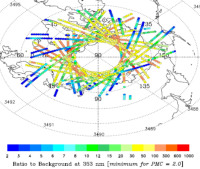
Updated: Jul 15, 2023
Each dot is a detected cloud. As the season progresses, these dots will multiply in number and shift in hue from blue to red as the brightness of the clouds intensifies.
What happened to NASA's AIM spacecraft, which has been monitoring NLCs since 2007? Earlier this year, the spacecraft's battery failed. As a result AIM is offline, perhaps permanently. There may be some hope of a recovery as AIM's orbit precesses into full sunlight in 2024. Until then, we will maintain AIM's iconic "daily daisy," frozen at Feb. 28, 2023, as a show of thanks for years of service and hope for future daisies:  |  |  | Switch view:Ross Ice Shelf, Antarctic Peninsula, East Antarctica, Polar Updated Jul16  SPACE WEATHER
NOAA Forecasts | | Updated at: 2023 Jul 16 2200 UTC FLARE | 0-24 hr | 24-48 hr | CLASS M | 60 % | 60 % | CLASS X | 25 % | 25 % |  Geomagnetic Storms: Geomagnetic Storms:
Probabilities for significant disturbances in Earth's magnetic field are given for three activity levels: active, minor storm, severe storm Updated at: 2023 Jul 16 2200 UTC Mid-latitudes | 0-24 hr | 24-48 hr | ACTIVE | 40 % | 35 % | MINOR | 30 % | 30 % | SEVERE | 05 % | 10 % | High latitudes | 0-24 hr | 24-48 hr | ACTIVE | 15 % | 15 % | MINOR | 30 % | 25 % | SEVERE | 45 % | 50 % | | | |  | | | | | | | | | | | This is an AI Free Zone! Text created by ChatGPT and other Large Language Models is spreading rapidly across the Internet. It's well-written, artificial, frequently inaccurate. If you find a mistake on Spaceweather.com, rest assured it was made by a real human being. | | | IS A 'CANNIBAL CME' COMING? One CME left the sun on July 14th, followed by a second faster CME on July 15th. According to a NOAA model, the second CME will sweep up the first, forming a 'cannibal CME' that hits Earth on July 18th. The impact could spark G1 to G2-class geomagnetic storms. Aurora alerts: SMS Text A DARK ERUPTION ON THE SUN (UPDATED): One of the most visually dramatic eruptions of Solar Cycle 25 occured on July 14th, when a spray of dark plasma flew away from the sun's southern hemisphere. NASA's Solar Dynamics Observatory recorded the event: 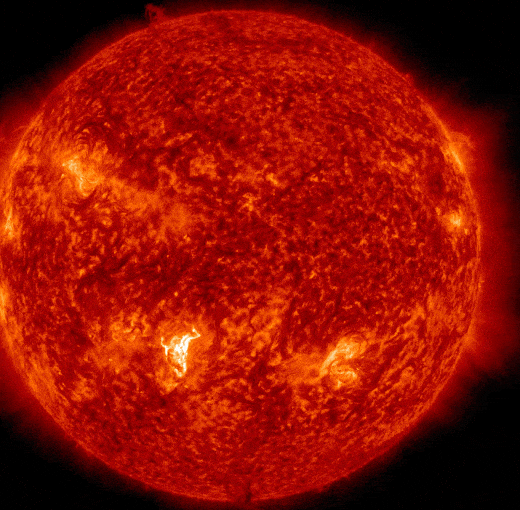
The explosion started in the magnetic canopy of AR3370, a small and previously unremarkable sunspot. X-ray sensors on Earth-orbiting satellites registered a C8.8-class solar flare at 1844 UT just before the dark ejecta appeared. What made it "dark"? It's not made of dark matter. Instead, plasma hurled away from the sunspot was relatively cool and dense, so it silhouetted the glow of the underlying sun. Update: New images from SOHO confirm that this eruption did indeed produce a CME. It is the first of two CMEs merging to form the cannibal CME described above. The second CME was launched into space on July 15th by a C-class flare from big sunspot AR3363: movie. Solar flare alerts: SMS Text Realtime Space Weather Photo Gallery
Free: Spaceweather.com Newsletter LASER-ETCHED MOON CUBE: Last week, the students of Earth to Sky Calculus launched a cosmic ray balloon to the stratosphere. This unique laser-etched Moon cube went along for the ride, ascending to an altitude of 101,140 feet: 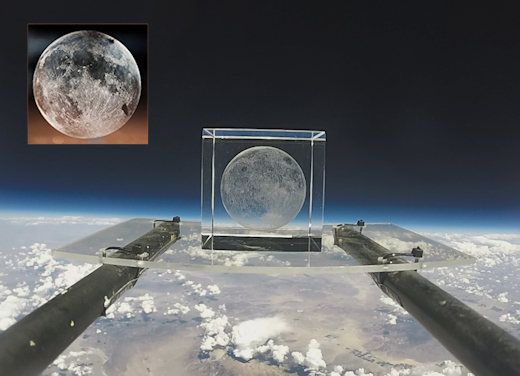
You can have it for $119.95. The students are selling these cubes as a fund-raiser for their cosmic ray ballooning program. It's an authentic representation of the Moon, with all of the craters, mountains and lava plains accurately portrayed. The Moon-cube comes with a unique gift card showing the item floating at the top of Earth's atmosphere. The interior of the card tells the story of the flight and confirms that this gift has been to the edge of space and back again. Far Out Gifts: Earth to Sky Store
All sales support hands-on STEM education
Realtime Aurora Photo Gallery
Free: Spaceweather.com Newsletter
Realtime Noctilucent Cloud Photo Gallery
Free: Spaceweather.com Newsletter Every night, a network of NASA all-sky cameras scans the skies above the United States for meteoritic fireballs. Automated software maintained by NASA's Meteoroid Environment Office calculates their orbits, velocity, penetration depth in Earth's atmosphere and many other characteristics. Daily results are presented here on Spaceweather.com. On Jul 15, 2023, the network reported 11 fireballs.
(11 sporadics) 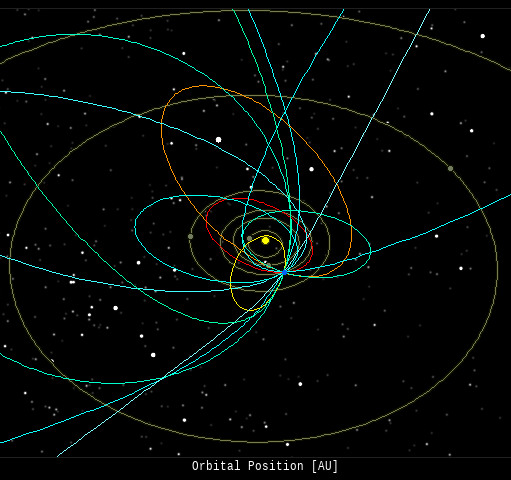 In this diagram of the inner solar system, all of the fireball orbits intersect at a single point--Earth. The orbits are color-coded by velocity, from slow (red) to fast (blue). [Larger image] [movies] Potentially Hazardous Asteroids ( PHAs) are space rocks larger than approximately 100m that can come closer to Earth than 0.05 AU. None of the known PHAs is on a collision course with our planet, although astronomers are finding new ones all the time. On July 16, 2023 there were 2335 potentially hazardous asteroids.
 | Recent & Upcoming Earth-asteroid encounters: | Asteroid | Date(UT) | Miss Distance | Velocity (km/s) | Diameter (m) | | 2023 MD2 | 2023-Jul-11 | 5.6 LD | 8.4 | 48 | | 2023 NE | 2023-Jul-11 | 11.3 LD | 12 | 43 | | 2023 MQ1 | 2023-Jul-11 | 10.8 LD | 6 | 39 | | 2018 UY | 2023-Jul-12 | 7.4 LD | 16.4 | 243 | | 2023 NU | 2023-Jul-12 | 8.4 LD | 15.7 | 63 | | 2023 NT1 | 2023-Jul-13 | 0.3 LD | 11.3 | 36 | | 2023 NP | 2023-Jul-14 | 13.1 LD | 8.2 | 21 | | 2023 NY | 2023-Jul-15 | 11.6 LD | 2.1 | 13 | | 2023 NU1 | 2023-Jul-15 | 13.3 LD | 16.2 | 112 | | 2023 NW | 2023-Jul-16 | 15.7 LD | 17.1 | 33 | | 2023 MG6 | 2023-Jul-16 | 9.5 LD | 12.4 | 286 | | 2020 UQ3 | 2023-Jul-18 | 3.2 LD | 9.3 | 59 | | 2023 NE1 | 2023-Jul-19 | 12.7 LD | 5.7 | 60 | | 2022 GX2 | 2023-Jul-20 | 11.9 LD | 9.4 | 5 | | 2023 NL | 2023-Jul-20 | 19.1 LD | 5.5 | 44 | | 2020 OM | 2023-Jul-20 | 8.5 LD | 9.5 | 14 | | 2023 NM1 | 2023-Jul-21 | 13.3 LD | 8.9 | 35 | | 2023 MX5 | 2023-Jul-21 | 11.9 LD | 11.8 | 63 | | 2023 NR1 | 2023-Jul-22 | 2.9 LD | 15.2 | 76 | | 2023 MM3 | 2023-Jul-22 | 19.1 LD | 6.4 | 45 | | 2015 MA54 | 2023-Jul-24 | 16.6 LD | 9.2 | 31 | | 2018 BG5 | 2023-Jul-27 | 10.7 LD | 8.4 | 56 | | 2020 PP1 | 2023-Jul-29 | 17 LD | 4.1 | 17 | | 2021 BD3 | 2023-Jul-30 | 14 LD | 8.5 | 25 | | 2016 AW65 | 2023-Jul-31 | 16.6 LD | 5.7 | 54 | | 2020 PN1 | 2023-Aug-03 | 10.8 LD | 4.8 | 29 | | 620082 | 2023-Aug-04 | 14 LD | 20.6 | 375 | | 2004 KG1 | 2023-Aug-06 | 18.7 LD | 9.2 | 54 | | 2022 BS2 | 2023-Aug-11 | 17.3 LD | 8.2 | 30 | | 2022 CP1 | 2023-Aug-17 | 13.8 LD | 9.8 | 12 | | 2011 QJ21 | 2023-Aug-19 | 13 LD | 15.1 | 45 | | 6037 | 2023-Aug-23 | 15.9 LD | 14.3 | 563 | | 2012 PZ17 | 2023-Aug-30 | 16.8 LD | 3.6 | 16 | | 2017 BY32 | 2023-Sep-02 | 16.4 LD | 3.5 | 20 | | 2021 JA5 | 2023-Sep-06 | 13.3 LD | 10.9 | 19 | | 2020 GE | 2023-Sep-08 | 14.9 LD | 1.4 | 8 | | 2020 RT2 | 2023-Sep-12 | 11 LD | 10 | 8 | Notes: LD means "Lunar Distance." 1 LD = 384,401 km, the distance between Earth and the Moon. 1 LD also equals 0.00256 AU. | | Cosmic Rays in the Atmosphere | SPACE WEATHER BALLOON DATA: Almost once a week, Spaceweather.com and the students of Earth to Sky Calculus fly space weather balloons to the stratosphere over California. These balloons are equipped with sensors that detect secondary cosmic rays, a form of radiation from space that can penetrate all the way down to Earth's surface. Our monitoring program has been underway without interruption for 7 years, resulting in a unique dataset of in situ atmospheric measurements. Latest results (July 2022): Atmospheric radiation is decreasing in 2022. Our latest measurements in July 2022 registered a 6-year low: 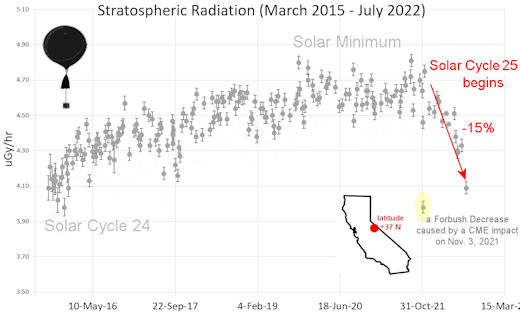
What's going on? Ironically, the radiation drop is caused by increasing solar activity. Solar Cycle 25 has roared to life faster than forecasters expected. The sun's strengthening and increasingly tangled magnetic field repels cosmic rays from deep space. In addition, solar coronal mass ejections (CMEs) sweep aside cosmic rays, causing sharp reductions called "Forbush Decreases." The two effects blend together to bring daily radiation levels down. .Who cares? Cosmic rays are a surprisingly "down to Earth" form of space weather. They can alter the chemistry of the atmosphere, trigger lightning, and penetrate commercial airplanes. According to a study from the Harvard T.H. Chan school of public health, crews of aircraft have higher rates of cancer than the general population. The researchers listed cosmic rays, irregular sleep habits, and chemical contaminants as leading risk factors. A number of controversial studies (#1, #2, #3, #4) go even further, linking cosmic rays with cardiac arrhythmias and sudden cardiac death. Technical notes: The radiation sensors onboard our helium balloons detect X-rays and gamma-rays in the energy range 10 keV to 20 MeV. These energies span the range of medical X-ray machines and airport security scanners. Data points in the graph labeled "Stratospheric Radiation" correspond to the peak of the Regener-Pfotzer maximum, which lies about 67,000 feet above central California. When cosmic rays crash into Earth's atmosphere, they produce a spray of secondary particles that is most intense at the entrance to the stratosphere. Physicists Eric Regener and Georg Pfotzer discovered the maximum using balloons in the 1930s and it is what we are measuring today. | | The official U.S. government space weather bureau | | | The first place to look for information about sundogs, pillars, rainbows and related phenomena. | | | Researchers call it a "Hubble for the sun." SDO is the most advanced solar observatory ever. | | | 3D views of the sun from NASA's Solar and Terrestrial Relations Observatory | | | Realtime and archival images of the Sun from SOHO. | | | information about sunspots based on the latest NOAA/USAF Active Region Summary | | | current counts of failed and deployed Starlink satellites from Jonathan's Space Page | | | Authoritative predictions of space junk and satellite re-entries | | | from the NOAA Space Environment Center | | | fun to read, but should be taken with a grain of salt! Forecasts looking ahead more than a few days are often wrong. | | | from the NOAA Space Environment Center | | | the underlying science of space weather |  | Getting YouTube comments is essential if you want to beat the algorithm! That’s why you need to buy YouTube comments from RealSocialz.com because they offer real USA comments you can customize. |  | When looking for casinos to play online when the weather is bad, you can try casino online trucchi for Italian games. If you are not from Finland you can try the Swedish page Svenska casino online to find suitable games, check out svenskacasinoonline.net. Always check your local laws before playing with real money. |  | BestCSGOGambling is the best site for everything related to CSGO gambling on the web | | | These links help Spaceweather.com stay online. Thank you to our supporters! | | | | | | | | |  | |  |   | ©2021 Spaceweather.com. All rights reserved. This site is penned daily by Dr. Tony Phillips. | |

